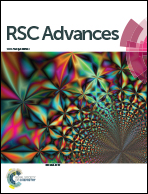Poly(γ-glutamic acid) induced homogeneous mineralization of the poly(ethylene glycol)-co-2-hydroxyethyl methacrylate cryogel for potential application in bone tissue engineering†
Abstract
Methacrylated poly(γ-glutamic acid) (mPGA) was introduced to the spongy poly(ethylene glycol)-co-2-hydroxyethyl methacrylate (PEG-HEMA) cryogels. A suitable amount (<0.1% w/v) of poly(γ-glutamic acid) (γ-PGA) in cryogels was found to promote homogeneous mineralization, while higher concentration of γ-PGA inhibited the mineralization. The deposited minerals mainly consisted of hydroxyapatite, carbonated apatite, and calcium phosphate, and were independent on the concentration of γ-PGA. The mineralized cryogels can support adhesion, viability, and migration of rat bone marrow stromal cells (rMSCs). The γ-PGA/HEMA-PEGDA cryogels showed their great potential as promising scaffolding materials in bone tissue engineering.


 Please wait while we load your content...
Please wait while we load your content...